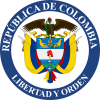Antonio Villavicencio
Antonio Villavicencio y Verástegui | |
|---|---|
 | |
| President of the United Provinces of New Granada* | |
| In office August 17, 1815 – November 15, 1815 | |
| Preceded by | Custodio García Rovira |
| Succeeded by | Camilo Torres Tenorio |
| Personal details | |
| Born | January 9, 1775 Santafé de Bogotá, Colombia |
| Spouse | Gabriela Sánchez Barriga y Brito |
| |
Antonio Villavicencio y Verástegui (January 9, 1775 – June 6, 1816) was a statesman and soldier of
Early life
Villavicencio was born on January 9, 1775, in
Villavicencio attended
In 1804 he returned to Spain and served in the navy in the Napoleonic Wars. He fought in the Battle of Trafalgar on October 25, 1805, serving as Second Lieutenant of Antonio de Escaño.
Villavicencio as representative of the Crown
In 1810 the Regency in Spain was concerned how news of the dissolution of the
, and Villavicencio as envoy to New Granada.Caracas
Villavicencio and his colleagues left Cádiz aboard the schooner La Carmen on March 1,[5] and arrived at La Guaira on March 18.[6] There they were urged to sail on to Caracas, where they arrived in time to witness the events of April 19, the day on which the people of Caracas deposed the Captain General of Venezuela, Vicente Emparán, and established a Venezuelan Supreme Junta, which gave way to the start of the First Republic of Venezuela.
Cartagena de Indias
After his stop in Venezuela, Villavicencio headed to
Santafé de Bogotá
In Santafé de Bogotá, capital of the Viceroyalty, word arrived of the events in Cartagena, and of the arrival of the Regency Commissioner Villavicencio in that city. The people of Santafé had been waiting anxiously for his arrival, as they hoped it would further their drive for independence.
While he was in Honda, Villavicencio was informed of the events of July 20 by Juan Merino, the alcalde of Honda.[11] When he arrived in Bogotá he was informed that the Junta no longer recognized the authority of the Regency Commission; he responded by resigning from the commission and embracing the patriotic cause.
Villavicencio immersed himself in the fight for independence, and was appointed commander of a battalion in the southern campaign of Antonio Nariño. In 1814 he was made the military advisor to the United Provinces of New Granada.
Triumvirate
On October 5, 1814, The Congress of the United Provinces replaced the presidency with a Triumvirate, a three-member executive body, to govern the nation. Custodio García Rovira, one of the members of the Triumvirate, presented his resignation on July 11, 1815, to Congress. Congress named Villavicencio to replace him.[12] Villavicencio accepted and on August 12, he resigned his post as Governor of Tunja,[12] and headed to Santafé de Bogotá, where he was inaugurated as President of the Triumvirate of the United Provinces of the New Granada.
His presidency was short lived, however; on November 15, 1815, Congress once again changed the executive power, entrusting it to a President Dictator and a vice president.[13]
Capture, trial and execution
After serving in the triumvirate, Villavicencio became Governor of Honda,[14] where on May 20, 1816[15] he was captured by the Royalist Army and transported to Santafé. On June 1 the Permanent Council of War sentenced Villavicencio to death. On June 6, he was taken out of his cell and his military insignia removed to degrade him, and then he was executed by a firing squad.[16] Thus Villavicencio, whose visit to Santafé had aroused the anger of the royalists and led to the colony breaking away from Spain, became the first victim of the reign of terror begun with the pacificación (pacification) campaign of the Spanish general, Pablo Morillo,[17] under which many other revolutionaries were sentenced to death, imprisoned or exiled.
Legacy
- Villavicencio, the capital of Meta Department and the largest city of the Orinoquía region of Colombia, was named in his honor.
See also
- Patria Boba
- Peninsular War
- Reconquista (Spanish America)
References
- ^ Titulos nobiliarios en el Ecuador (Page 88) BY José Alejandro Guzman
- ^ Antonio de Villavicencio (el protomartir) y la Revolución de la independencia (Page 4), By José Dolores Monsalve
- ^ Biografías de los mandatarios y ministros de la Real Audiencia(1671 a 1819) By José María Restrepo Sáenz
- ^ Colombia and the United States, 1765-1934 (Page 63) By E. Taylor Parks [1]
- ^ Biblioteca de historia nacional (Page 158) By Colombian Academy of History
- ^ Ecuatoriana de Estudios Historicos Americanos. (Page 165) by Ecuadorian Academy of History
- ^ The Independence of Spanish America (Page 150) By Jaime E. Rodríguez [2]
- ^ Historia eclesiástica y civil de Nueva Granada: Escrita sobre documentos auténticos (pages 53-56) By José Manuel Groot [3]
- ^ La Independencia de Colombia (Pages 139-144) By Rafael Gómez Hoyos
- ^ History of Colombia (Page 200) By Jesús María Henao, Gerardo Arrubla [4]
- ^ "Antonio Villavicencio, Javier Ocampo Lopez". Archived from the original on August 5, 2009. Retrieved July 31, 2007.
- ^ a b Biblioteca Luis Ángel Arango Archived August 10, 2007, at the Wayback Machine
- ^ Estudios constitucionales sobre los gobiernos de la América Latina By Justo Arosemena
- ^ El precursor: Documentos sobre la vida pública y privada del General Antonio Nariño (Page XIX) By Eduardo Posada [5]
- ^ Biblioteca de historia nacional By Colombian Academy of History
- ^ La Patria Boba By J. A. Vargas Jurado, José María Caballero, José Antonio de Torres y Peña [6]
- ^ Obras completas de Diego Barros Arana(Page 309) By Diego Barros Arana [7]

